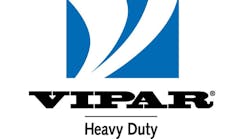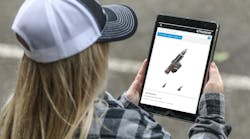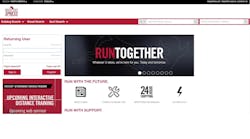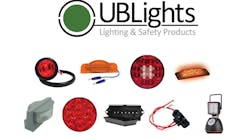To address the increasing popularity of new-generation wide-base single tires, Canada's Council of Ministers Responsible for Transportation and Highway Safety approved several amendments to the Memorandum of Understanding (MOU) on Vehicle Weights and Dimensions, including increased weight limits and minimum track width requirement for axles.
The MOU, which went into effect July 1, 2008, has been amended to include the following clause that applies to axles except steering axles: Its axle loads, when an axle is fitted with two single tires, each of which has a width of 445 mm or greater, do not exceed 7700 kg for single axles and 15,400 kg for tandem axle groups.
The Council noted that while the new wide-base single-tire designs offer improvements in fuel efficiency, vehicle roll stability, reduced tare weight, and reduced impacts on pavement compared to the older single tires, they still appear to have slightly higher impacts than the dual-tire configuration they replace if used at dual-tire loads.
So to improve the consistency of weight limits applicable to use of these tires across Canada, while also protecting highway infrastructure, the national standards for weight limits on single and tandem axle groups were increased to the federal limits currently applicable in the United States.
“According to research, this change should not have detrimental impacts on pavements in Canada, as the impacts associated with the wide single tires at the new weight limits would be no more than the impacts associated with conventional dual-tire axles at their current weight limits,” the Council stated.
The Council said that replacing dual tires with the new-generation single tires on existing trailers can result in a violation of the minimum track width requirement stipulated in the MOU (2.5 meters).
“Representation from industry indicated that use of axle spacers or rims with large offsets can compensate for the dimensional deficiency, but can create other problems due to higher stresses in axle and wheel bearing,” the council said. “This situation can be avoided with purchase of new trailers, as longer axles can be fitted on the trailer when single tires are to be used. To avoid creating potentially unsafe situations, the minimum track width requirement has been relaxed for carriers who wish to retrofit existing trailers with new wide base single tires.”
The MOU has been amended to include the following clauses: The minimum track width for trailer axles fitted with single tires must be no less than 2.3 meters (90.55") for trailers built in 2007 or earlier. The minimum track width for all axles on trailers built in 2008 or later must be no less than 2.5 meters (98.43").
Francois Beauchamp, special project coordinator for Michelin North America Inc, said that “in order to meet the new regulation, trailers manufactured in 2008 and beyond must use a 83.5" axle installed with 0" outset wheels if it is to be equipped with wide-base single tires. If a customer decided to go in that way to take advantage of wide-base singles, he must realize that if he wants to go back to duals with 83.5", he can't do it.”
Beauchamp said rolling resistance accounts for approximately 35% of the fuel consumed by a tractor-trailer. Each 3% reduction in rolling resistance results in a 1% fuel savings. Trailer tires can offer that economy, he said.
“Changing a vehicle from dual to single tires will reduce overall weight by 200 pounds per axle,” he said. “This will allow a fleet to increase the amount of revenue generating cargo it can carry.
“Here's an actual scenario: Fleet X operates 12 tractor-trailers transporting bulk material. Each tractor does three trips per day. The vehicle configuration is one steer axle, two drive axles, and three trailer axles. By fitting each unit with wide-base singles, it reduces the weight and increases the load capacity by 1000 pounds. 12 × 3 × 5 days × 1,000 lb =180,000 lb and 50 weeks × 180,000=9,000,000 lb. So if you had a nickel for every extra pound, you'd have $450,000.”
He said that to retrofit wide-base singles, make sure you have the corresponding size (11R22.5=455/55R22.5 and 275/80R22.5=445/50R22.5) and the proper wheels and offset.
Beauchamp said the proper choice of tire for the application will allow fleets to save money in the future.
“Using a low-cost tire can result in high costs later,” he said. “Look at the premium tire to be put on the trailers. In the long run, it's not a benefit for the customer to put on a lower-end tire because it will be a higher cost later on. Therefore you want to offer a tire that can be retreaded more than once.”
How many times can the casing be re- treaded? He said casings can come from any wheel position, but retreads can only be placed on drive and trailer positions.
“Fleets that run an effective retread program will be limited by supply, as the bulk of the first life casings will come from the steer position or new equipment. When a fleet removes re-treaded casings from a drive or trailer position, they will need to generate new casings, which can only come from the steer position, the purchase of a ‘cap and casing,’ or the purchase of new drive or trailer tires. The more lives a fleet can generate from its casings, the more it can reduce the need for outside purchases.”
Self-steering axles
Rudy Wosing of IMT Ingersoll Axles said that on a typical leading king pin steering axle, the center line of the king pin is 5" ahead of the center line of the axle beam. And on a typical in-line steering axle, the center line of the king pin is the same as the center line of the axle beam.
“On leading king pin self-steering axles, the axle does not require input from the driver in order to turn,” he said. “It follows the direction of the vehicle while supporting the load. It's also called self-castering.”
He said capacities vary by manufacturer. Generally, there are three classes: 25,000 lb (heavy duty), 16,000 lb (light duty), and 13,000 lb (front steer axle).
“SSA wheel end uses the same components as primary trailer axles,” he said.
Wosing said there are three bearing groups:
-
F22, taper spindle, TN, D22. The most popular trailer bearings in the industry are HM218248 and HM212049.
-
F24, parallel spindle, TP, P22, Propar: HM518445, HM518445.
-
F23, European spindle, HM218248, X33213.
Wosing said SSA use S-cam air brakes commonly found on trucks and trailers. They have the same geometry and components as standard trailer axles, many lining types are available, they are FMVSS121- and CMVSS121-certified, and typically are 16.5" × 7", 16.5" × 5", and 15" × 4".
He said SSA use the same hubs and drums that are used on trailers and front axles, with the 10 stud hub pilot being the most common.
Self-steering axles are required equipment for those building SPIF-compliant equipment (Safe, Productive, Infrastructure-Friendly vehicles), he said. When the distance from the turn center to the self-steering axle is 4.65 or fewer meters, the minimum wheel cut (angle of rotation) is 20 degrees. With incremental increases in the distance, the wheel cut is 25, 28, and 30 degrees.
He said that when mixing suspensions (Ridewell lift/ HT250 primary), SPIF legislates an equalization of no more than 500 kg. SPIF legislates that all steering axle wheel ends are ABS-equipped. There are different weight ratings for super singles versus duals.
Wosing said a trailer designer needs to know: type of trailer and service; total number and location of axles; type of suspension required; ride height; axle track; vehicle overall width; tire and wheel sizes and capacities; and frame construction and size.
“The resulting design can take full advantage of the self-steering axle benefits,” he said.
He said a trailer builder needs to know: caster; alignment; and toe-in adjustment.
- Caster Procedure IN015.
“Ensure the correct caster angle — the angle created between the vertical axis of the king pin and vertical axis of the axle tube. Changing tire diameters on the SSA or primary suspension will affect the SSA caster position. Increasing the SSA tire diameter will cause the SSA caster to go negative, which is undesirable. In a lot of cases when the axle is installed in a suspension at ride height, I'm finding that the suspension is put upside down. When I'm out in the field, I see that they are actually installed as a negative, and not positive, caster. That negative gives you a ‘shopping cart’ effect. As soon as you push it, it wobbles back and forth. That's exactly what happens with these.
“Changing the tractor fifthwheel height will affect the caster position. For every inch on a manufacturer's-specified fifthwheel height that you go lower on, you take a degree of caster out of that axle, as well as the suspension ride height.”
- Alignment Procedure IN016.
“Install and center the axle in the suspension and set the caster on the SSA. Secure by hard tack welding or clamping. Center the axle and suspension on the vehicle centerline using the king pin center for reference. Set the fixed axle alignment. Safely hard tack weld the suspension into place. Vertify caster at working height again. When axle and suspension are correctly aligned and caster is correct, complete all welding per recommendations. Remove the shipping bar and verify toe-in and alignment again. If king pin location is correct, adjust alignment at spindle end using the centralizer position volts. Centralizer bag must be a normal working pressure.”
- Toe-In Adjustment Procedure IN020.
“Tires must be of the same size, pressure, and tread pattern. Hubs, drums, and brakes must be identical. All suspension bushings and parts must be in good mechanical order and correctly adjusted. Scribe a fine line on the tire tread all around the tire. Measure between the scribed lines on tires in front and on the back, on axle center line. “A” must be shorter than “B” by 1/16” to 1/8”, when axle/suspension is normally loaded. Adjust by rotating the tie-rod with the axle unloaded. Tie-rod ends must be square with stud, and guide plate must be centered in U-bracket before tightening the clamps. Tighten all the clamp bolts and the tie-rod end nuts to 200 ft-lb of torque. Check toe-in after each adjustment until the axle is within specification.”
He listed the features of an IMT Self Steering Axle: less tire drag; induction heat-treated spindles; 20, 25, 28, and 30 degrees steering capability; North American designed and manufactured; forgings provided by IMT's own forging business (Port Colborne, Ontario); spindles/spiders from North American suppliers; friction-welded beams manufactured on-site in Ingersoll, Ontario; many different track widths available with F22, F23, or F24 spindles; flexible suspension-mounting capabilities.
The benefits: better fuel mileage; longer life and high strength; improved stability; more maneuverability; more design opportunities; parts are readily available from distributors throughout North America; better control of product and rapid design changes; local employment, better quality; lighter weight axle (no plug welds); numerous selection of standard and non-standard tracks allows for adaptability to customers' needs; provides true tracking capability; and can be mounted on several suspension models from all North American suspension manufacturers.
Nitrogen inflation and tire rotation
Brian Rennie of Bridgestone said nitrogen inflation has been used for aircraft tires and large off-road tires for many years, is required on braked wheels of all aircraft over 75,000 lb take-off weight, and is widely used in racing car tires.
It can even be beneficial for highway truck tires.
He listed these claims made for nitrogen inflation:
- Less inflation pressure loss due to diffusion.
“Both static and dynamic inflation pressure loss is reduced by the use of nitrogen inflation. Nitrogen does not diffuse through the tire inner liner as quickly as air. Oxygen is more soluble in rubber than nitrogen . Air is about 78% nitrogen, 21% oxygen, and 1% argon and other trace gases. Commercial nitrogen inflation is 95% to 99+% nitrogen. At 25 degrees Celsius, oxygen can permeate the inner liner about four times faster than nitrogen. At 50 degrees, oxygen can permeate the inner liner about three times faster than nitrogen. In a static test, air had 38% greater pressure loss. In a dynamic (drum) test, air had 55% greater pressure loss. Nitrogen inflation retains pressure better than air inflation.”
- Less oxidation of tire components.
“Oxidation of rubber compounds is a big enemy of truck tire durability. Nitrogen inflation reduces the oxidation degradation of rubber components in truck tires. Nitrogen inflation reduces the loss of compound physical properties compared to air inflation. The reduction in physical property loss results in better retained drum life.”
- Less pressure buildup in service.
“Nitrogen inflation is with dry nitrogen. Air inflation usually contains water and water vapor — sometimes, a lot of water. Water vapor pressure increases with temperature. Even a very slight amount of water will affect the buildup of pressure as the temperature of the contained air increases. Dry nitrogen inflation reduces service pressure variation. In racing tires, pressure variation is very significant and dry nitrogen inflation is critical. In truck tires, pressure variation difference is not very significant, the percentage of change is smaller, increased pressures reduces deflection and lowers running temperatures, and pressure variation also works in reverse — less change when traveling from warm to cold climates.”
- Lower tire running temperature.
“Many brochures claim nitrogen inflation results in lower tire running temperatures. Inflation pressure is maintained better with nitrogen inflation than with air inflation. Higher inflation pressure results in reduced deflection and lower running temperatures. Good inflation pressure maintenance with air should give the same results.”
- Longer tread life.
“Many brochures claim nitrogen inflation provides longer tread wear life. Again, inflation pressure is maintained better with nitrogen than with air inflation. Higher inflation pressure results in reduced deflection, lower running temperatures, and generally better wear life.”
- Less chance of a tire explosion of internal gases.
“Risk of explosion is greatly reduced as oxygen is reduced from 21% to 1-5%. The conditions that cause an explosion in truck tires are very rare — only at very high temperatures where out-gassing of flammable vapors from rubber components could occur. Excessive brake heat is the most probable cause. This is why the nitrogen inflation is required on aircraft tires on braked wheels of all aircraft over 75,000 lb takeoff weight.”
- Less oxidation of wheels.
“With less oxygen, there is less oxidation of the wheels. Nitrogen inflation is dry, and a lack of water and water vapor greatly reduces the oxidation process of steel. Less oxygen and water penetrating to steel cords is a major advantage for long term tire performance.”
“All factors would indicate that these benefits could/should show improvement, but solid data to prove this is hard to come by. Most data or available information is testimonial or anecdotal in nature. To answer these questions, carefully structured evaluations are needed to determine if the improvements are significant enough to show up in the bottom line of tire costs. These evaluations need to be large enough to randomize normal variation and long enough to include retread history.”
Regarding tire rotation, he said rotation is a practical means of reducing tire costs when irregular or rapid wear are prevalent. Rotation patterns, such as those recommended by vehicle manufacturers, may be followed.
“There are no restrictions on cross rotation,” he said. “Tires having directional type tread patterns should be mounted in the recommended direction of rotation for optimum performance. The casing, after retreading, may be run in either direction, as the casing is not directional.”
He said rotation helps achieve maximum removal miles.
“It will equalize wear rates,” he said. “With a steer tire, the left front tire typically wears faster than the right front. With a drive, the rear tandem drive axle typically wears faster than front tandem drive axle. With a trailer, the front axle on spread tandems typically wears faster than rear axle. With tridems, the front and rear axles typically wear faster than the center axle.
“It will minimize uneven wear. The right front steer tire typically is more prone to outer shoulder uneven wear. Drive tires are susceptible to heel-toe wear. Drive and trailer tires are susceptible to inner shoulder wear due to negative camber induced by load.”








